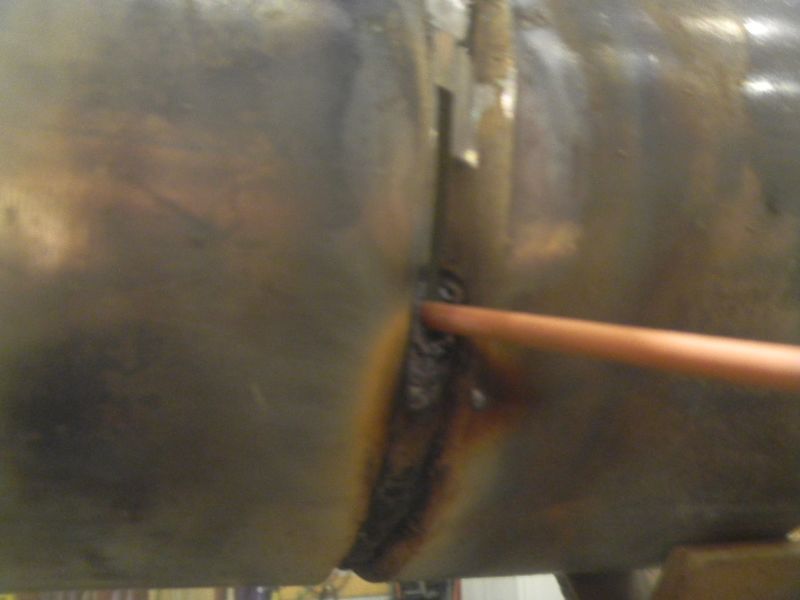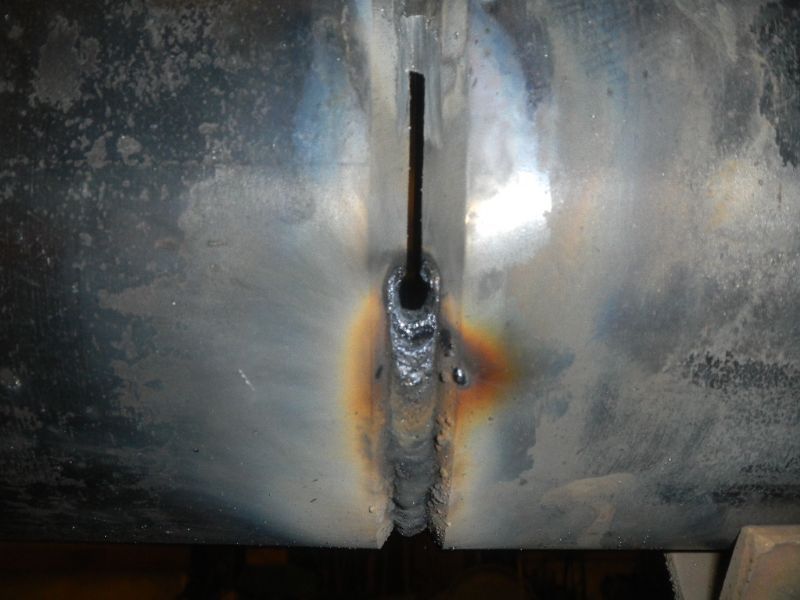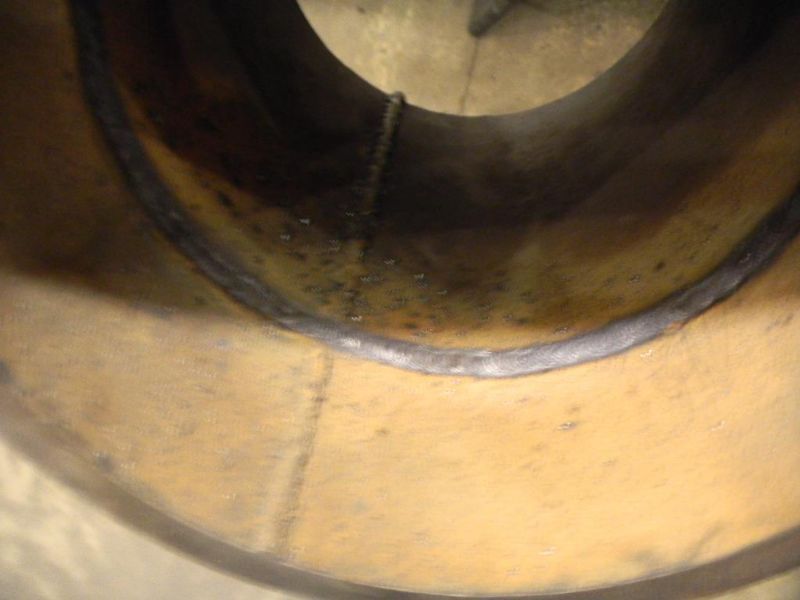Been doing some open root 6010 on 3/8 plate 1/8 land and gap with 1/8 rod at ~65 amps and dig on 7
The root looks great until I run out of rod and have to start a new one. Then there is a lack of penetration about 1/4 inch and then looks great again. I can fix this with a grinder if I feather it and am able to punch through the weld but I've been told not to use it as a cruch and go do it without a grinder. Anybody have tips to get better penetration at the restarts?
Stick Welding Tips, Certification tests, machines, projects
Kinda how I feel about it. At work, I would grind my tacks or millscale or do any other precaution to prevent weld discontinuities on parts or repairs. Might have to have him show me what he wants. I don't usually get demos from him since I have a lot of experience already and pick up fairly quick.
Country isn't country unless it's classic.
- Shield Arc
-
Guide

-
Posts:
-
Joined:Tue May 28, 2013 11:10 am
-
Location:Figuring the picking points of jelly donuts
You should always feather grind your starts and stops.
One thing I do with open root welding. When the rod is just about burned up, and I have to stop and change rods. I punch the rod right through the groove. This gives you a small hole. Feather grind the area, and when you start back with the new rod, it’s a perfect tie in.
One thing I do with open root welding. When the rod is just about burned up, and I have to stop and change rods. I punch the rod right through the groove. This gives you a small hole. Feather grind the area, and when you start back with the new rod, it’s a perfect tie in.
- MinnesotaDave
-
Weldmonger

-
Posts:
-
Joined:Sun Oct 27, 2013 10:57 pm
-
Location:Big Lake/Monticello MN, U.S.A.
Ya know, I've heard that several times and always forget to try the punch through method.Shield Arc wrote:You should always feather grind your starts and stops.
One thing I do with open root welding. When the rod is just about burned up, and I have to stop and change rods. I punch the rod right through the groove. This gives you a small hole. Feather grind the area, and when you start back with the new rod, it’s a perfect tie in.
Guess I'm slow some times
I agree, feather it and no worries
Dave J.
Beware of false knowledge; it is more dangerous than ignorance. ~George Bernard Shaw~
Syncro 350
Invertec v250-s
Thermal Arc 161 and 300
MM210
Dialarc
Tried being normal once, didn't take....I think it was a Tuesday.
Beware of false knowledge; it is more dangerous than ignorance. ~George Bernard Shaw~
Syncro 350
Invertec v250-s
Thermal Arc 161 and 300
MM210
Dialarc
Tried being normal once, didn't take....I think it was a Tuesday.
- Shield Arc
-
Guide

-
Posts:
-
Joined:Tue May 28, 2013 11:10 am
-
Location:Figuring the picking points of jelly donuts
Ive always been told that feathering all starts/stops is the right way to do an open root, but quite often we all take short cuts. When Im feeling lazy and dont feather, I just make sure to start my next weld back between 1/4 and 3/8s back and push through. It gets the weld hot and usually ties in pretty good.
- Otto Nobedder
-
Weldmonger

-
Posts:
-
Joined:Thu Jan 06, 2011 11:40 pm
-
Location:Near New Orleans
Actually yeah I got some pointers and its not that big of a deal to me anymore. It's basically leaving it as thin as you can at the stop and then when lighting up weld over it getting it hot enough to push through and tie into the bead. I'd rather grind it for sure but I prefer to know both ways.
Country isn't country unless it's classic.
wheresmejumper
- wheresmejumper
-
Guide

-
Posts:
-
Joined:Mon Jan 14, 2013 6:14 pm
-
Location:Ireland
A tig root!Otto Nobedder wrote:You may encounter a test that does not allow grinding at all.
That's where the money is.
Dancing with the blue lady
Start depositing metal with your new rod about a quarter inch before you keyhole, do this in order to build up some heat so you can punch through the backside of the old keyhole, hold the rod there for just a sec to start filling it in then continue running out the joint, are you allowed to grind the highs and lows of your root pass after it is in?
Example is Red Seal, you can't use any angle grinder at all, just bench grinder to clean the coupon from tacks to the fixture or to do the land and wire brush (well, you can use hacksawOtto Nobedder wrote:You may encounter a test that does not allow grinding at all.
That's where the money is.
What position is it you welding
E.g. 45 degrees inclined overhead I have done by starting with long arc above about 1/4" going down bit below of the bottom of the keyhole and then after heating it up about a second or bit longer perform little push and start whip as usually.
Overhead pretty same with good push but no whip.
In each case you have to heat it up to let it fuse together
Slawkos
Return to “Stick Welding/Arc Welding - Shielded Metal Arc Welding”
Jump to
- Introductions & How to Use the Forum
- ↳ Welcome!
- ↳ Member Introductions
- ↳ How to Use the Forum
- ↳ Moderator Applications
- Welding Discussion
- ↳ Metal Cutting
- ↳ Tig Welding - Tig Welding Aluminum - Tig Welding Techniques - Aluminum Tig Welding
- ↳ Mig and Flux Core - gas metal arc welding & flux cored arc welding
- ↳ Stick Welding/Arc Welding - Shielded Metal Arc Welding
- ↳ Welding Forum General Shop Talk
- ↳ Welding Certification - Stick/Arc Welding, Tig Welding, Mig Welding Certification tests - Welding Tests of all kinds
- ↳ Welding Projects - Welding project Ideas - Welding project plans
- ↳ Product Reviews
- ↳ Fuel Gas Heating
- Welding Tips & Tricks
- ↳ Video Discussion
- ↳ Wish List
- Announcements & Feedback
- ↳ Forum News
- ↳ Suggestions, Feedback and Support
- Welding Marketplace
- ↳ Welding Jobs - Industrial Welding Jobs - Pipe Welding Jobs - Tig Welding Jobs
- ↳ Classifieds - Buy, Sell, Trade Used Welding Equipment
- Welding Resources
- ↳ Tradeshows, Seminars and Events
- ↳ The Welding Library
- ↳ Education Opportunities





